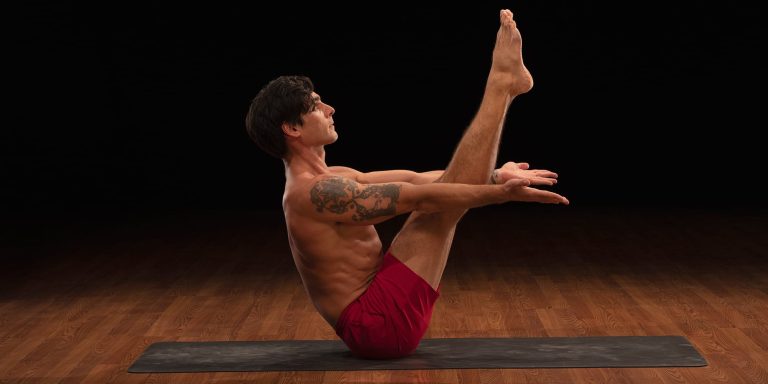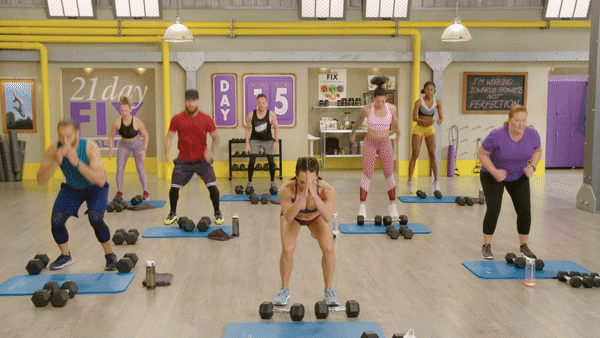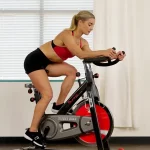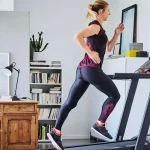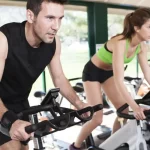Houston, TX 77099
Benefits of Plyometrics
If you’re looking to become a faster, more agile athlete, you may have heard of plyometrics. Whether your goal is to improve your vertical jump, increase speed, or enhance agility, incorporating plyometric exercises into your training regimen can be highly beneficial.
Even if athletics are not your main focus, plyometrics can still play a valuable role in your fitness routine. Here’s a closer look at what plyometrics entail and how they can positively impact your overall performance.
What Are Plyometrics?
Formerly known as “jump training,” plyometrics is a form of exercise that emphasizes the combination of strength and speed to enhance power output.
Commonly utilized in various sports like basketball, soccer, and tennis, plyometric training can help improve athleticism, strengthen key muscle groups, and provide a range of other benefits.
Let’s explore the advantages of integrating plyometric exercises into your workout routine and how you can do so safely.
The Benefits of Plyometrics
Engaging in plyometric exercises involves a dynamic process that requires your muscles, tendons, ligaments, and joints to work together to generate force and absorb impact effectively. This process involves eccentric and concentric contractions (muscle lengthening and shortening).
“Plyometric training targets your type II (fast twitch) muscle fibers, which are the largest, strongest, and most powerful fibers in your body,” explains Trevor Thieme, C.S.C.S.
“Whether you’re a seasoned weight lifter or new to strength training, research indicates that plyometrics can be as effective as traditional weightlifting for muscle building. Combining both methods can help you achieve your fitness goals more efficiently than focusing on one alone.”
Furthermore, the impact from landing during plyometric exercises can contribute to bone density, while enhancing agility and explosiveness for athletes performing quick, responsive movements like sprints, directional changes, and jumps.
How to Get Started With Plyometrics
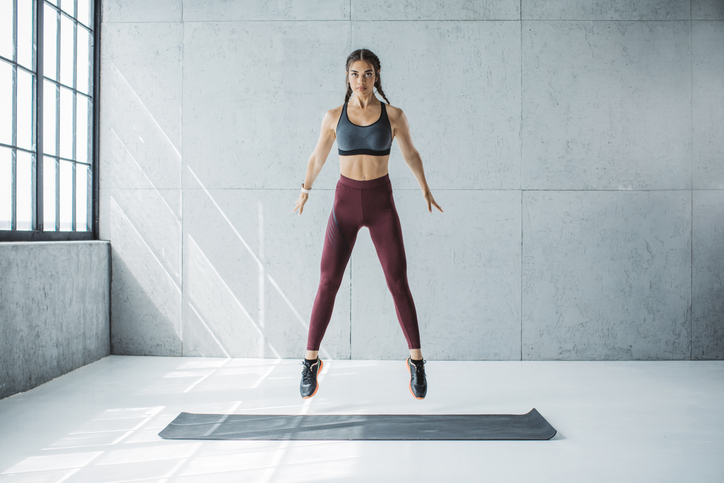
If you’re new to plyometrics, it’s essential to begin gradually and prioritize proper form. This is especially crucial for plyometric exercises due to the necessity of executing movements with precision and control during both the takeoff and landing phases.
Thieme recommends incorporating plyometric elements into exercises you’re already familiar with to ease the transition.
“For instance, you can substitute jump squats for regular squats, or include split jumps alongside conventional lunges,” he suggests.
When learning a new plyometric movement, you can start by practicing without the jumping component to focus on form, strength, and stability. Once you feel confident in these areas, you can gradually add the jumping element.
Another approach is to begin with lower-impact plyometric exercises such as jumping jacks, skipping rope, lateral hops, and certain martial arts or boxing drills involving punches and kicks.
Additionally, don’t overlook the upper body: Plyo push-ups and medicine ball throws are effective for developing explosive power in the upper body muscles.
Always prioritize maintaining proper form, especially as fatigue sets in. Poor form can increase the risk of injury.
Are There Individuals Who Should Avoid Plyometrics?
Generally speaking, plyometric exercises are safe for most individuals, unless there are specific medical reasons prohibiting participation (e.g., joint issues or knee problems identified by a healthcare professional).
However, Thieme advises caution for significantly overweight individuals, recommending a gradual introduction of plyometric exercises and avoiding high-impact movements like box jumps until strength and conditioning levels improve.
“Overexerting yourself too soon or attempting advanced exercises prematurely can strain your joints and elevate the risk of injury,” he warns.
10 Plyometric Exercises to Boost Your Power
While many associate plyometrics with lower-body workouts, these exercises can also target the upper body effectively.
Below are ten plyometric exercises that engage various major muscle groups in the body:
1. Box Jumps
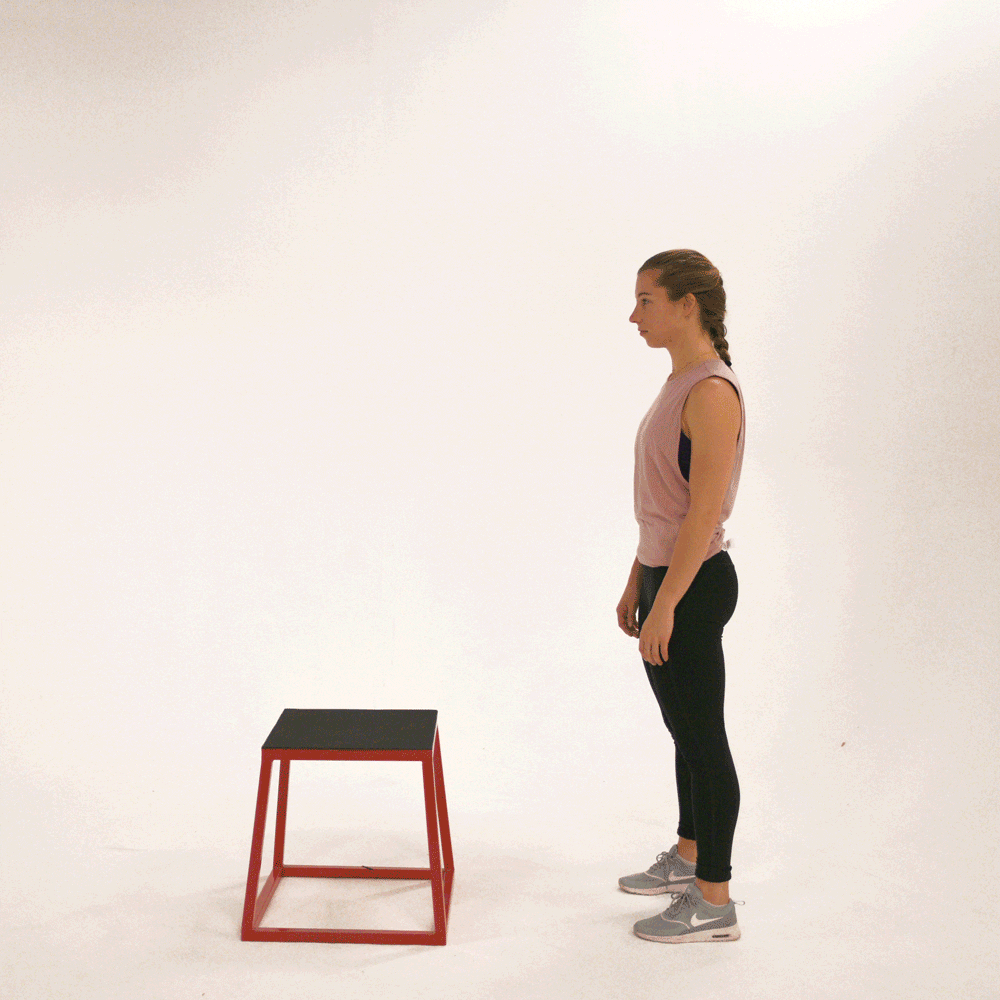
-
- Stand facing a box or stable elevated surface with your feet hip-width apart, knees bent into a quarter squat, and arms positioned behind you.
-
- Swing your arms forward, jump onto the box, landing with bent knees and both feet on the center of the box.
-
- Stand up, then step down from the box one foot at a time.
2. Skater Jumps
-
- Begin with your right leg slightly bent and left foot tucked behind it.
-
- Push off your right leg to shift your body to the left, landing on your left leg with your right leg tucked behind.
-
- Continue lateral jumps, landing softly with bent knees each time.
3. Plyo Push-Ups
-
- Assume a plank position with feet together (or slightly apart), body straight from head to heels, and hands aligned with (but slightly wider than) shoulders.
-
- Engage your core and glutes to maintain a stable position.
-
- Lower your body, keeping elbows close to ribs, until chest is a few inches from the floor.
-
- Push up forcefully, allowing hands to leave the ground.
-
- Land softly and transition into the next repetition.
4. Tuck Jump
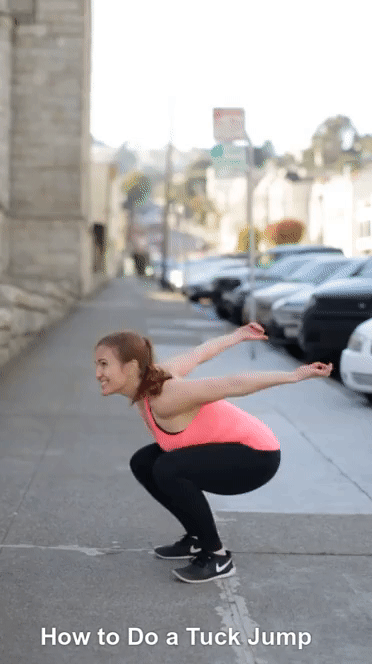
-
- Stand with feet hip-width apart, arms extended at chest level.
-
- Bend knees into a quarter squat, then jump explosively off the balls of your feet.
-
- As you jump, bring knees toward chest, aiming to touch palms.
-
- Land softly with knees slightly bent and feet hip-width apart.
5. (Continued)
Split jump
-
- Stand in a staggered stance with your right foot about two to three feet in front of your left foot. Let your arms hang by your sides.
-
- Keeping your chest up, back straight, and core engaged, lower yourself into a lunge: front thigh parallel to the floor, rear knee bent to about 90 degrees.
-
- Jump straight up so that both feet leave the floor. Swing your arms up in front of your chest will help optimize your momentum and power.
-
- Switch leg positions in the air, landing softly with your left foot forward.
-
- Immediately lower your body back into a lunge to begin your next rep.
-
- Continue alternating legs with each rep.
6. Standing chest pass

-
- Stand at least three feet away from the wall with your feet shoulder-width apart (soften your knees to protect your joints). Hold the a soft wall ball between your hands at chest height.
-
- Engage your core and press down into the floor with your feet. Explosively throw the wall ball into the wall as hard as possible and catch it on its return.
-
- Continue to throw the ball back and forth repeatedly for reps.
7. Wall ball side slam

-
- Stand sideways with your left shoulder a little more than arms-length away from a wall. Place your feet shoulder-width apart. Hold a wall ball with both hands at belly height and extend your arms out in front of you. Soften your elbows.
-
- Twist your torso away from the wall toward the center of the room. Then, turn your torso quickly back toward the wall to throw the ball against the wall as hard as possible.
-
- Catch the ball on the rebound and repeat continuously for the assigned rep count. Turn and repeat the drill on the other side.
8. Wide in & out abs
Workout: INSANITY – Max Interval Plyo
-
- Assume a plank position with your hands in line with (but slightly wider than) your shoulders, and your feet wider than hip distance.
-
- Squeeze your glutes and brace your core to keep your body in a straight line.
-
- Keeping your hands on the ground, jump your feet in to come under your hips, keeping the feet shoulder-width apart.
-
- Then, jump back to the starting position.
9. Scissor kick jumps
Workout: P90X3 – AgilityX
-
- Stand on your right leg, with your left leg lifted straight out in front of your body.
-
- Moving to the left, jump to your left leg, lifting your right leg straight out in front of your body.
-
- Switch once more to your right leg, and then once more to your left leg.
-
- Then reverse the direction jumping to your right, still alternating legs.
10. Overhead slams
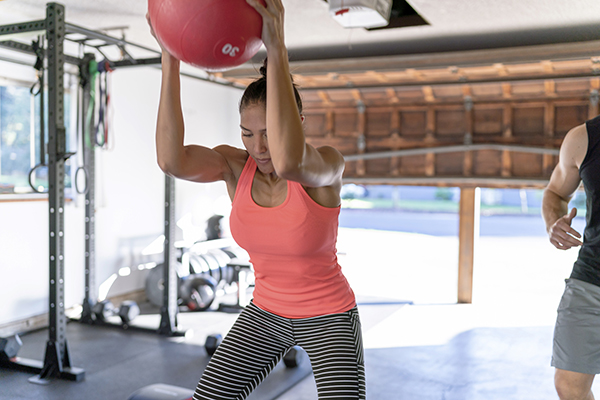
-
- Stand with feet hip-width apart and a soft bend in the knees, and hold the medicine ball with both hands over your head.
-
- With explosive force, slam the ball to the ground, engaging your core and glutes while putting more bend in your knees and pushing your hips back slightly. Try to slam the ball hard enough so it bounces back upward.
-
- Catch the ball and raise it back overhead.


